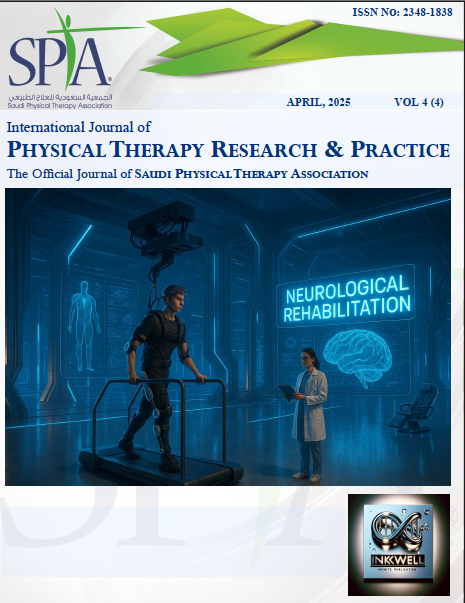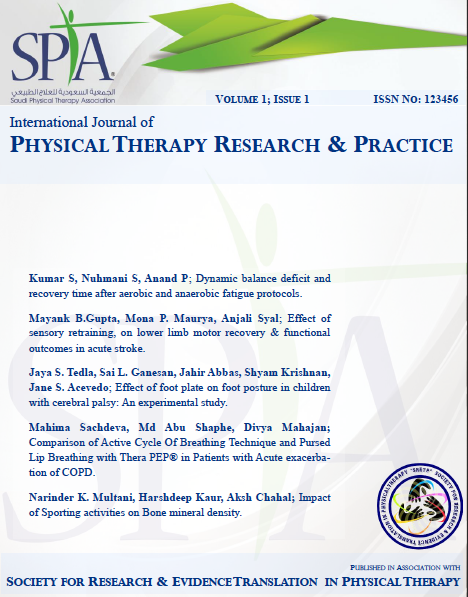Effectiveness of Self-administered High Frequency pocket TENS in pain intensity, and workability among university students with Primary Dysmenorrhea – A quasi-experimental study design
DOI:
https://doi.org/10.62464/ijoprp.v4i4.101Keywords:
Primary Dysmenorrhea, Transcutaneous Electrical Nerve Stimulation (TENS), MenstruationAbstract
Background: Primary Dysmenorrhea (PD) is a painful condition affecting women of childbearing age, often hindering daily tasks. In Physical Therapy, Transcutaneous Electrical Nerve Stimulation (TENS) is widely used to relieve pain without side effects. Our study assesses the effectiveness of self-administered high-frequency pocket TENS (HF TENS) in reducing pain and enhancing workability among university students with PD in Jazan, Saudi Arabia. Methods: A quasi-experimental study involving 51 female university students was conducted. Participants received HF TENS with a pulse frequency of 100Hz for 30 minutes from day 1 to day 3 of their menstrual cycle. Pain intensity was assessed using the Numerical Pain Rating Scale (NPRS) for lower abdomen pain (LAP) and low back pain (LBP). The Workability, Location, Intensity, Days of Pain, and Dysmenorrhea (WaLIDD) score was used to determine dysmenorrhea severity. Pre-intervention and post-intervention assessments were conducted on day 1 and day 3 of the menstrual cycle, respectively. Results: The Wilcoxon signed-rank test revealed a significant reduction in pain intensity for both LAP (Median pre-6; post-1) and LBP (Median pre-5; post-1) following HF TENS application (p < 0.001). Similarly, a significant improvement in dysmenorrhea severity was observed (p < 0.001). Fisher's exact test indicated a statistically significant association between HF TENS treatment and dysmenorrhea severit. Conclusion: Self-administered HF pocket TENS application effectively reduces pain intensity and improves workability among university students with PD in Jazan, Saudi Arabia.
References
Abd Elaziz, K. S. A. E., Ph. D., Mohammed, R. E., Kamel, H. A.-D. H., & Mohamed, A. S. (2022). Effect of Pulsed Electro Magnetic Field versus Transcutaneous Electrical Nerve Stimulation on Menstrual Distress of Primary Dysmenorrhea. The Medical Journal of Cairo University, 90(6), 681–688. https://doi.org/10.21608/mjcu.2022.253117
Adil, R., & Zaigham, U. (2021). Prevalence of primary dysmenorrhoea and its effect on instrumental activities of daily living among females from Pakistan. Physiotherapy Quarterly, 29(4), 65–69. https://doi.org/10.5114/pq.2021.105754
Arik, M. I., Kiloatar, H., Aslan, B., & Icelli, M. (2022). The effect of TENS for pain relief in women with primary dysmenorrhea: A systematic review and meta-analysis. EXPLORE, 18(1), 108–113. https://doi.org/10.1016/j.explore.2020.08.005
Bai, H.-Y., Bai, H.-Y., & Yang, Z.-Q. (2017). Effect of transcutaneous electrical nerve stimulation therapy for the treatment of primary dysmenorrheal. Medicine, 96(36), e7959. https://doi.org/10.1097/MD.0000000000007959
Dawood, M. Y. (2006). Primary Dysmenorrhea: Advances in Pathogenesis and Management. Obstetrics & Gynecology, 108(2), 428. https://doi.org/10.1097/01.AOG.0000230214.26638.0c
Dawood, M. Y., & Ramos, J. (1990). Transcutaneous electrical nerve stimulation (TENS) for the treatment of primary dysmenorrhea: A randomized crossover comparison with placebo TENS and ibuprofen. Obstetrics and Gynecology, 75(4), 656–660.
De Arruda, G. T., Driusso, P., Rodrigues, J. C., de Godoy, A. G., & Avila, M. A. (2022). Numerical rating scale for dysmenorrhea-related pain: A clinimetric study. Gynecological Endocrinology, 38(8), 661–665. https://doi.org/10.1080/09513590.2022.2099831
Desai, R. G. (2022). Physiotherapy Intervention for Primary Dysmenorrhea – A Narrative Review. International Journal of Research and Review, 9(3), 441–449. https://doi.org/10.52403/ijrr.20220349
Elboim-Gabyzon, M., & Kalichman, L. (2020). Transcutaneous Electrical Nerve Stimulation (TENS) for Primary Dysmenorrhea: An Overview. International Journal of Women’s Health, 12, 1–10. https://doi.org/10.2147/IJWH.S220523
Faul, F., Erdfelder, E., Lang, A.-G., & Buchner, A. (2007). G*Power 3: A flexible statistical power analysis program for the social, behavioral, and biomedical sciences. Behavior Research Methods, 39(2), 175–191. https://doi.org/10.3758/BF03193146
Ferries-Rowe, E., Corey, E., & Archer, J. S. (2020). Primary Dysmenorrhea: Diagnosis and Therapy. Obstetrics & Gynecology, 136(5), 1047. https://doi.org/10.1097/AOG.0000000000004096
Gerzson, L. R., Padilha, J. F., Braz, M. M., & Gasparetto, A. (2014). Physiotherapy in primary dysmenorrhea: Literature review. Revista Dor, 15, 290–295. https://doi.org/10.5935/1806-0013.20140063
Guy, M., Foucher, C., Juhel, C., Rigaudier, F., Mayeux, G., & Levesque, A. (2022). Transcutaneous electrical neurostimulation relieves primary dysmenorrhea: A randomized, double-blind clinical study versus placebo. Progrès En Urologie, 32(7), 487–497. https://doi.org/10.1016/j.purol.2022.01.005
Hashim, R. T., Alkhalifah, S. S., Alsalman, A. A., Alfaris, D. M., Alhussaini, M. A., Qasim, R. S., & Shaik, S. A. (2020). Prevalence of primary dysmenorrhea and its effect on the quality of life amongst female medical students at King Saud University, Riyadh, Saudi Arabia. Saudi Medical Journal, 41(3), 283–289. https://doi.org/10.15537/smj.2020.3.24988
Igwea, S. E., Tabansi-Ochuogu, C. S., & Abaraogu, U. O. (2016). TENS and heat therapy for pain relief and quality of life improvement in individuals with primary dysmenorrhea: A systematic review. Complementary Therapies in Clinical Practice, 24, 86–91. https://doi.org/10.1016/j.ctcp.2016.05.001
Itani, R., Soubra, L., Karout, S., Rahme, D., Karout, L., & Khojah, H. M. J. (2022). Primary Dysmenorrhea: Pathophysiology, Diagnosis, and Treatment Updates. Korean Journal of Family Medicine, 43(2), 101–108. https://doi.org/10.4082/kjfm.21.0103
Johnson, M. (2007). Transcutaneous Electrical Nerve Stimulation: Mechanisms, Clinical Application and Evidence. Reviews in Pain, 1(1), 7–11. https://doi.org/10.1177/204946370700100103
Johnson, M. I., Paley, C. A., Howe, T. E., & Sluka, K. A. (2015). Transcutaneous electrical nerve stimulation for acute pain. The Cochrane Database of Systematic Reviews, 2015(6), CD006142. https://doi.org/10.1002/14651858.CD006142.pub3
Lauretti, G. R., Oliveira, R., Parada, F., & Mattos, A. L. (2015). The New Portable Transcutaneous Electrical Nerve Stimulation Device Was Efficacious in the Control of Primary Dysmenorrhea Cramp Pain. Neuromodulation: Technology at the Neural Interface, 18(6), 522–527. https://doi.org/10.1111/ner.12269
Lee, B., Hong, S. H., Kim, K., Kang, W. C., No, J. H., Lee, J. R., Jee, B. C., Yang, E. J., Cha, E.-J., & Kim, Y. B. (2015). Efficacy of the device combining high-frequency transcutaneous electrical nerve stimulation and thermotherapy for relieving primary dysmenorrhea: A randomized, single-blind, placebo-controlled trial. European Journal of Obstetrics, Gynecology, and Reproductive Biology, 194, 58–63. https://doi.org/10.1016/j.ejogrb.2015.08.020
Li, X., Sun, Y., Wang, Y., Wang, X., & Yu, C. (2024). Manual Therapy in Primary Dysmenorrhea: A Systematic Review and Meta-Analysis. Journal of Pain Research, 17, 1663. https://doi.org/10.2147/JPR.S457381
Manisha, U., & Anuradha, L. (2021). Effect of high frequency transcutaneous electrical nerve stimulation at root level menstrual pain in primary dysmenorrhea. Journal of Bodywork and Movement Therapies, 26, 108–112. https://doi.org/10.1016/j.jbmt.2020.12.025
McKenna, K. A., & Fogleman, C. D. (2021). Dysmenorrhea. American Family Physician, 104(2), 164–170. https://www.aafp.org/pubs/afp/issues/2021/0800/p164.html
Muragod, A., Mathias, O., & Bhoir, P. (2017). Effectivenesss of Transcutaneous Electrical Nerve Stimulation and Diadynamic Current on Primary Dysmenorrhea: A Randomized Clinical Trial. Journal of Medical Science And Clinical Research, 05(03), 18557–18562. https://doi.org/10.18535/jmscr/v5i3.48
Rashidi Fakari, F., Simbar, M., Tahmasebi, G., Ebadi, A., Rashidi Fakari, F., Nasiri, M., & Ghazanfarpour, M. (2021). Efficacy of Working Ability, Location, Intensity, Days of Pain, Dysmenorrhea (WaLIDD) and Verbal Rating Scale (Pain and Drug) in Diagnosing and Predicting Severity of Dysmenorrhea among Adolescents: A Comparative Study. Journal of Obstetrics, Gynecology and Cancer Research, 6(2), 81–86. https://doi.org/10.30699/jogcr.6.2.81
Ricciotti, E., & FitzGerald, G. A. (2011). Prostaglandins and Inflammation. Arteriosclerosis, Thrombosis, and Vascular Biology, 31(5), 986–1000. https://doi.org/10.1161/ATVBAHA.110.207449
Teherán, A. A., Piñeros, L. G., Pulido, F., & Mejía Guatibonza, M. C. (2018). WaLIDD score, a new tool to diagnose dysmenorrhea and predict medical leave in university students. International Journal of Women’s Health, 10, 35–45. https://doi.org/10.2147/IJWH.S143510
Tugay, N., Akbayrak, T., Demirtürk, F., Karakaya, I. C., Kocaacar, O., Tugay, U., Karakaya, M. G., & Demirtürk, F. (2007). Effectiveness of transcutaneous electrical nerve stimulation and interferential current in primary dysmenorrhea. Pain Medicine (Malden, Mass.), 8(4), 295–300. https://doi.org/10.1111/j.1526-4637.2007.00308.x
Vance, C. G., Dailey, D. L., Rakel, B. A., & Sluka, K. A. (2014). Using TENS for pain control: The state of the evidence. Pain Management, 4(3), 197–209. https://doi.org/10.2217/pmt.14.13
Weissman, A. M., Hartz, A. J., Hansen, M. D., & Johnson, S. R. (2004). The natural history of primary dysmenorrhoea: A longitudinal study. BJOG: An International Journal of Obstetrics and Gynaecology, 111(4), 345–352. https://doi.org/10.1111/j.1471-0528.2004.00090.x.

Downloads
Published
Issue
Section
License
Copyright (c) 2025 International Journal of Physical Therapy Research & Practice

This work is licensed under a Creative Commons Attribution-NonCommercial-NoDerivatives 4.0 International License.




